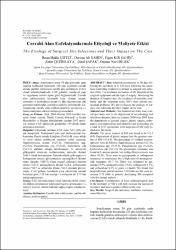| dc.contributor.author | Çiftçi, İhsan Hakkı | |
| dc.contributor.author | Şahin, Dursun Ali | |
| dc.contributor.author | Kır Şahin, Figen | |
| dc.contributor.author | Çetinkaya, Zafer | |
| dc.contributor.author | Şafak, Birol | |
| dc.contributor.author | Dilek, Osman Nuri | |
| dc.date | 2015-01 | |
| dc.date.accessioned | 2015-01-30T08:52:45Z | |
| dc.date.available | 2015-01-30T08:52:45Z | |
| dc.date.issued | 2005-09 | |
| dc.identifier.issn | 1302-4612 | |
| dc.identifier.uri | http://hdl.handle.net/11630/1794 | |
| dc.description.abstract | Amaç: Ameliyattan sonra 30 gün içerisinde yada
implant kullanılan hastalarda 120 gün içerisinde cerrahi
alanda görülen enfeksiyon cerrahi alan enfeksiyon (CAE)
olarak adlandırılmaktadır. CAE gelişimi, cerrahi alt yapı
ve uygulanan cerrahi tipine göre değişmektedir. Cerrahi
alan enfeksiyonları hastanede yatış süresini uzatan,
mortalite ve morbiditeyi artıran ve ülke ekonomisine yük
getirmesi bakımından cerrahinin ciddi bir problemidir. Çalışmamızda
cerrahi alan enfeksiyonlarının eyolojisini ve
tadavi maliyetine etkisini tartışmayı amaçladık.
Gereç ve Yöntem: Ocak 2004-Haziran 2005 tarihleri arasında
Genel cerrahi, Plastik Cerrahi, Ortopedi ve Kadın
Hastalıkları ve Doğum kliniklerinde yapılan 2187 ameliyat
sonrası CAE şüphesiyle gönderilen 149 klinik örnek
çalışmaya alınmıştır.
Bulgular: Çalışmada ortalama CAE oranı %3.2 (69) olarak
hesaplandı. Postoperatif yara yeri enfeksiyonları bakımından
Plastik cerrahi kliniğinin (%4.8) ilk sırayı aldığı
ve izole edilen enfeksiyon etkenleri sıklık sırasının;
Staphylococcus aureus (%27.0), Enterococcus spp.
(%19.0), Pseudomonas spp. (%16.0), Escherichia coli
(%13.5) şeklinde olduğu belirlenmiştir. S. aureus’da
glikopeptid direncine rastlanmazken, metisilin direnci
%48.3 olarak bulunmuştur. Enterokoklarda glikopeptid ve
karbapenem direnci gözlenmezken aminoglikozit direnci
oranı yüksekti (%85.7). Gram negatif izolatların kinolon
direnci %35.5, aminoglikozit direnci %19.4, karbapenem
direnci %9.7 ve seftazidim direnci %6.5 oranında gözlenmiştir.
CAE gelişen hastalarda yatış sürelerinin normal
hastalara göre 2-20 kat uzadığı ve maliyetin de 2-75 kat
arttığı saptanmıştır.
Sonuç: CAE’nin tedavisinde lokal epidemiyolojik verilerin
dikkate alınmasının tedavideki başarıyı arttıracağını ve
maliyet üzerine olumlu katkılar sağlayacağını düşünmekteyiz. | en_US |
| dc.description.abstract | Aim: Infection encountered in 30 days following
the operation or in 120 days following the operations
(including implants) is termed as surgical site infection
(SSI). The incidence and nature of SSI depends on the
surgical equipment and the type of surgery. Increasing the
duration of hospital stay, the incidence of mortality, morbidity
and the treatment costs, SSI’s bear serious economical
problems. We aim to discuss the etiology of surgical
site infections and their impact on the cost.
Material and Methods: One hundred and forty nine clinical
specimens sent to the department of microbiology and
infectious diseases, between January 2004-June 2005 from
the departments of general surgery, plastic surgery, orthopedics
and traumatology and obstetrics and gynecology (in
a total of 2187 operations) with suspicion of SSI were included
in this study.
Results: The mean amount of SSI was found to be %3.2
(69). Department of plastic surgery had the greatest number
of SSI’s (%4.8). The percentage of isolated microorganisms
were as follows: Staphylococcus aureus (%27.0),
Enterococcus spp. (%19.0), Pseudomonas spp. (%16.0),
Escherichia coli (%13.5). No glycopeptid resistance was
found in S. aureus species but methycilline resistance was
about 48.3%. There were no glycopeptide or carbapenem
resistance in enterococci but a high ratio of aminoglycoside
resistance (85.7 %). There was resistance to quinolone
35.5%, aminoglycosides 19.4%, carbapenem 9.7%,
and ceftazidime 6.5% in gram (-) bacilli. We found that
hospitalization period increase 2-20 folds and the costs increases
2-75 folds in patients developing SSI compared
with the normal patients
Conclusion: Consideration of local epidemiological data
in the treatment of SSI’s will both increase the success of
treatment and have a positive effect on the cost.
Key Words: Surgical site infections, antibiotic resistance, cost effectivity . | en_US |
| dc.language.iso | tur | en_US |
| dc.publisher | Afyon Kocatepe Üniversitesi, Kocatepe Tıp Dergisi | en_US |
| dc.rights | info:eu-repo/semantics/openAccess | en_US |
| dc.subject | Cerrahi Alan Enfeksiyonu | en_US |
| dc.subject | Antibiyotik | en_US |
| dc.title | Cerrahi alan enfeksiyonlarında etiyoloji ve maliyete etkisi | en_US |
| dc.title.alternative | The etiology of surgical site infections and their impact on the cost | en_US |
| dc.type | article | en_US |
| dc.relation.journal | Afyon Kocatepe Üniversitesi, Kocatepe Tıp Dergisi | en_US |
| dc.department | Afyon Kocatepe Üniversitesi, Tıp Fakültesi, Mikrobiyoloji ve Klinik Mikrobiyoloji Anabilim Dalı
Afyon Kocatepe Üniversitesi, Tıp Fakültesi, Genel Cerrahi Anabilim Dalı
Afyon Kocatepe Üniversitesi, Tıp Fakültesi, Kadın Hastalıkları ve Doğum Anabilim Dalı | en_US |
| dc.identifier.volume | 6 | en_US |
| dc.identifier.startpage | 17 | en_US |
| dc.identifier.endpage | 22 | en_US |
| dc.identifier.issue | 3 | en_US |
| dc.relation.publicationcategory | Makale - Ulusal Hakemli Dergi - Kurum Yayını | en_US |



















